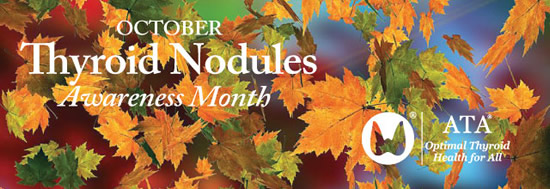
Clinical Thyroidology for the Public summarizes selected research studies discussed in the previous month’s issue of Clinical Thyroidology, an official publication of the American Thyroid Association. Editor-in-chief, Alan Farwell, MD, FACE
 Available in pdf format for saving and printing and Web page format for viewing online
Available in pdf format for saving and printing and Web page format for viewing online
PDF Format for Saving and Printing
Clinical Thyroidology for the Public Volume 14 Issue 10 (PDF file, 5.24 MB)
TABLE OF CONTENTS – Web Format
THYROID NODULES
A new thyroid nodule electronic tool to guide management decisions
Thyroid nodules are very common and it is important to distinguish low-risk from high-risk thyroid nodules to appropriately diagnose and treat thyroid cancer. A task force of experts created a Web-based tool to provide guidance on the initial evaluation and treatment of patients with thyroid nodules. The article describes the development and details of this novel electronic tool.
Garber JR et al 2021 American Association of Clinical Endocrinology and Associazione Medici Endocrinologi thyroid nodule algorithmic tool. Endocr Pract 27:649–660. PMID: 34090820.
THYROID CANCER
Risk factors for recurrence of follicular thyroid cancer
Follicular thyroid carcinoma is the second most common type of thyroid cancer. Despite this, risk factors for recurrence of follicular thyroid carcinoma are not well defined. The purpose of this study is to systematically review the risk factors for follicular thyroid carcinoma recurrence.
Grønlund MP et al Risk factors for recurrence of follicular thyroid cancer: A systematic review. Thyroid. Epub 2021 Jul 5. PMID: 34102860.
THYROID NODULES
Repeated biopsies of thyroid nodules to perform molecular testing reduces need for thyroid surgery
Overall, ~ 10-15% thyroid nodule biopsies are indeterminate, which means that the cells are not either clearly abnormal or clearly normal. Molecular marker testing may be helpful in evaluating indeterminate nodules but us expensive. In this study, the authors analyze a unique clinical group of patients in whom repeat biopsy was obtained prior to molecular testing in almost all cases to evaluate the implications of performing a repeat biopsy before molecular diagnostic testing indeterminate nodules.
Nishino M et al 2021 Repeat fine needle aspiration cytology refines the selection of thyroid nodules for Afirma gene expression classifier testing. Thyroid. Epub 2021 Apr 3. PMID: 33813868.
HYPERTHYROIDISM
Rate of remission is the most important determinant for treatment decision-making in Graves’ disease
Graves’ disease, can be treated by: antithyroid drugs, surgery or radioactive iodine therapy. Each one of these treatments have different benefits and risks. This study was done to try to understand which factors affect the treatment preferences in patients and clinicians and compare both of them.
van Kinschot CMJ et al 2021 Preferences of patients and clinicians for treatment of Graves’ disease: A discrete choice experiment. Eur J Endocrinol 184:803–812.
GRAVES’ EYE DISEASE
Effect of radioactive iodine therapy on thyroid eye disease
Radioactive iodine therapy is currently the most common treatment for Graves’ disease in the United States. Radioactive iodine therapy has also been associated with worsening of thyroid eye disease, particularly in smokers. Because of this, there are different treatment strategies currently in use to dose radioactive iodine in Graves’ disease. These investigators examined the effect of three different radioactive iodine dosing protocols on treatment of hyperthyroidism and thyroid eye symptoms due to Graves’ disease.
Ariamanesh S et al 2020 Effect of different 131I dose strategies for treatment of hyperthyroidism on Graves’ ophthalmopathy. Clin Nucl Med 45:514–518. PMID: 32433165.
HYPOTHYROIDISM
New formulations of levothyroxine may benefit select patients
Levothyroxine most commonly comes in the form of a tablet. Recently, liquid and gel cap forms of levothyroxine have become available. This study was conducted to identify whether levothyroxine in liquid or gel forms provide a better intestinal absorption and more stable thyroid hormone levels in patients.
Nagy EV et al 2021 New formulations of levothyroxine in the treatment of hypothyroidism: Trick or treat? Thyroid 31:193–201. PMID: 33003978.


